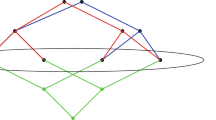Abstract
In this paper we suggest new scaling algorithms for the assignment and minimum mean cycle problems. Our assignment algorithm is based on applying scaling to a hybrid version of the recentauction algorithm of Bertsekas and the successive shortest path algorithm. The algorithm proceeds by relaxing the optimality conditions, and the amount of relaxation is successively reduced to zero. On a network with 2n nodes,m arcs, and integer arc costs bounded byC, the algorithm runs in O(\(\sqrt n \) m log(nC)) time and uses very simple data structures. This time bound is comparable to the time taken by Gabow and Tarjan's scaling algorithm, and is better than all other time bounds under thesimilarity assumption, i.e.,C = O(n k) for somek. We next consider the minimum mean cycle problem. Themean cost of a cycle is defined as the cost of the cycle divided by the number of arcs it contains. Theminimum mean cycle problem is to identify a cycle whose mean cost is minimum. We show that by using ideas of the assignment algorithm in an approximate binary search procedure, the minimum mean cycle problem can also be solved in O(\(\sqrt n \) m lognC) time. Under the similarity assumption, this is the best available time bound to solve the minimum mean cycle problem.
Similar content being viewed by others
References
A.V. Aho, J.E. Hopcroft and J.B. Ullman,The Design and Analysis of Computer Algorithms (Addison-Wesley, Reading, MA, 1974).
R.K. Ahuja, T.L. Magnanti and J.B. Orlin, “Network flows,” in:Handbooks in Operations Research and Management Science. Vol. I: Optimization (North-Holland, Amsterdam, 1989).
D.P. Bertsekas, “A distributed algorithm for the assignment problem,” Working Paper, Laboratory for Information and Decision Systems, MIT (Cambridge, MA, 1979).
D.P. Bertsekas, “The auction algorithm: a distributed relaxation method for the assignment problem,” Technical Report LIDS-P-1653, MIT (Cambridge, MA, 1987).
D.P. Bertsekas and J. Eckstein, “Dual coordinate step methods for linear network flow problems,”Mathematical Programming 42 (1988) 203–243.
D.P. Bertsekas and D.A. Castanon, “The auction algorithm for the minimum cost network flow problem,” LIDS Technical Report, MIT (Cambridge, MA, 1989).
L.D. Bodin, B.L. Golden, A.A. Assad and M.O. Ball, “Routing and scheduling of vehicles and crews,”Computers and Operations Research 10 (1983) 65–211.
R. Dial, “Algorithm 360: shortest path forest with topological ordering,”Communications of the ACM 12 (1969) 632–633.
E. Dijkstra, “A note on two problems in connexion with graphs,”Numerische Mathematik 1 (1959) 269–271.
E.A. Dinic, “Algorithm for solution of a problem of maximum flow in networks with power estimation,”Soviet Mathematics Doklady 11 (1970) 1277–1280.
S. Even and R.E. Tarjan, “Network flow and testing graph connectivity,”SIAM Journal of Computing 4 (1975) 507–518.
R.L. Francis and J.A. White,Facility Location and Layout: An Analytical Approach (Prentice-Hall, Englewood Cliffs, NJ, 1974).
M.L. Fredman and R.E. Tarjan, “Fibonacci heaps and their uses in network optimization algorithms,”Proceedings 25th Annual IEEE Symposium on Foundation of Computer Science (1984) pp. 338–346.
H.N. Gabow and R.E. Tarjan, “Almost-optimum speed-ups of algorithms for bipartite matchings and related problems,”Proceedings of the 20th Annual ACM Symposium on Theory of Computing (1988) pp. 514–527.
A.V. Goldberg and R.E. Tarjan, “Solving minimum cost flow problem by successive approximation,”Proceedings of the 19th ACM Symposium on the Theory of Computing (1987) pp 136–146.
A.V. Goldberg and R.E. Tarjan, “Finding minimum-cost circulations by canceling negative cycles,”Proceedings of the 20th ACM Symposium on Theory of Computing (1988) pp. 388–397.
J.E. Hopcroft and R.M. Karp, “Ann 5/2 algorithm for maximum matching in bipartite graphs,”SIAM Journal of Computing 2 (1973) 225–231.
R.M. Karp, “Probabilistic analysis of partitioning algorithms for the traveling salesman problem in the plane,”Mathematics Operations Research 2 (1977) 209–224.
R.M. Karp, “A characterization of the minimum cycle mean in a digraph,”Discrete Mathematiccs 23 (1977) 309–311.
R.M. Karp and J.B. Orlin, “Parametric shortest path algorithms with an application to cyclic staffing,”Discrete Applied Mathematics 3 (1981) 37–45.
E.L. Lawler,Combinatorial Optimization: Networks and Matroids (Holt, Rinehart and Winston, NY, 1976).
J.B. Orlin, “The complexity of dynamic languages and dynamic optimization problems,”Proceedings of the 13th Annual ACM Symposium on the Theory of Computing (1981) pp. 218–227.
J.B. Orlin and R.K. Ahuja, “New distance-directed algorithms for maximum flow and parametric maximum flow problems,” Sloan, W.P. No. 1908–87, Sloan School of Management, MIT (Cambridge, MA, 1987).
E. Tardos, “A strongly polynomial minimum cost circulation algorithm,”Combinatorica 5 (1985) 247–255.
E. Zemel, “A linear time randomizing algorithm for searching ranked functions,”Algorithmica 2 (1987) 81–90.
Author information
Authors and Affiliations
Rights and permissions
About this article
Cite this article
Orlin, J.B., Ahuja, R.K. New scaling algorithms for the assignment and minimum mean cycle problems. Mathematical Programming 54, 41–56 (1992). https://doi.org/10.1007/BF01586040
Received:
Revised:
Issue Date:
DOI: https://doi.org/10.1007/BF01586040




